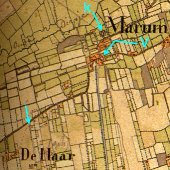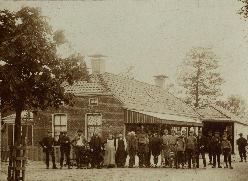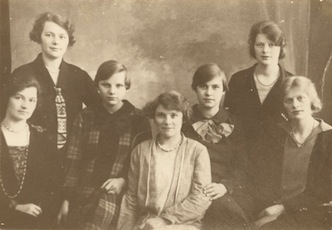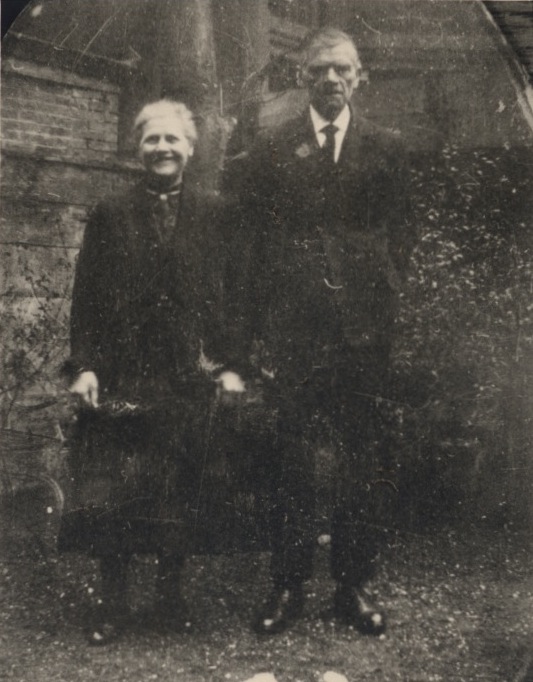Klaas Posthumus was the son of a merchant family.
Klaas "rented" as of 1892 the post of toll collector in Niebert.
He also did some agriculture and he traded in horses.
For details see the
advertisements Niebert.
After his fathers death in 1902 his mother ran a shop in Nuis.
Later his younger brother Gerrit continued the shop.
Liena Hofstede was the daughter of a small-hold farmer north of Marum.
She had a son Freerk (*25-07-1892).
Klaas (36 years of age) and Liena (25 years old)
married in 1897 in Marum (Westerkwartier, Gr).
At their marriage Liena's earlier child was
legally recognised.
At first they still lived in Niebert, at the toll.
Renske and Hendrikje were born here.
Toward the end of 1900 they moved to a small farm on the westside of Marum.
The farm was on a sandy road by the mill,
in the direction of "De Haar" (see map).
There, Janna, Wiebrigje, Anne and Klaziena were born.
"The heath there came up to the windowsill.
Pa opened up heath land and he had some farm animals.
He had horses with which he used to trade a lot.
But the farm went poorly and the cows got splenic fever (anthrax)."
as Wieb remembered later.
And Jo (Janna) recounted:
"Pa often sold horses to the same farmers.
He must have been an honest tradesman."
Children of Klaas and Liena: (1892 Freerk, x Nienke Dalstra), 1898 Renske (x Egbert Nicolaas), 1900 Hendrikje (Hens), both in Niebert, and then in Marum: 1901 Janna (Jo), 1902 Wiebrichje (Wieb/Wyb), 1903 Anne, 1905 Klazina (Sien), 1906 child(+), 1908 Klazelina (Liena), 1912 Dien, 1916 Klaas.
Jo later told: In 1905 a lot of cattle died of anthrax. I do remember seeing of and on a dead cow in the cow stable. In 1905 they left the farm, it was sold (see advertisements). Klaas then bought the café in Marum West from the merchant Fokke Helmholt, an uncle of Liena. (Fokke was married to Janneske Posthumus, a daughter of Klaas Hofstede and Roliena Hemsing.) The café was at the intersection of roads in Marum West (see map). There were often sales in the café.

|
The week market was across from the café on "'t Kampje" (south side of the main road). A lot of trading went on in the café.
Om 1 May 1906 Klaas officially took over the café from uncle B. Hemholt (see advertisement in the Nieuwsblad van het Noorden). He also announced in the newspaper a theatre play, without admission fee.
|
November 1906 is the first time he calls the café "De Veehandel" (Cattle trade). Dealers slept for free in the hay.
The café was rather a "public house", a pub. It had a stage (there was place for music), and meetings could be held there. When a notary public had to organise a public sale in the area, it often took place in the café of K. Posthumus (announcements in the newspaper).
In this house Lien, Dien and Klaas were born. There were many bedrooms. The girls slept in double beds (as told later by Wieb) and in changing combinations.
Daughter Sien told later:
"Mother was a strong woman.
One day, I was 12 years old,
the headmaster of the school came into the school vegetable garden,
where I did some work.
He came toward me and pinched my legs.
I reported this at home right away.
Mother was indignant and went to the master to protest.
Although a headmaster was part of the "upper class"
of the village, Mother had no problems.
Mother was always forewardly.
She had good taste in clothing.
She worked a large vegetable garden and
they always ate fresh vegetables and lettuce.
She was convivial.
We were a close family, she and Pa seldom quarreld.
Liena took care that the children always looked good.
In winter they wore dark clothes and stockings,
in summer light coloured dresses and stockings.
Several school photos exist
in which the girls invariably wear a white dress.
There also exist several small individual photos of the girls
in a nice dress and a charming necklace.
|
Occasionally, children teased Sien about her red hair
(also Anne had red hair).
Liena then would say: "They do that because they envy you".
When the children quarreled or made too much noise,
Liena only had to look in a certain manner and then everybody knew
to behave. The children were never spanked.
Klaas was a busy man: he managed the café, farmed his land and traded in horses. He had half a dozen cows and some pigs but foremost he had horses. When some were sold son Anne (then aged 10) would bring them to the buyer (as told by Anne's daughter, Tiny). The children Wieb and Jo helped by milking the cows. All business went well and Klaas bought again plots of heath at "de Haar" to open up and make into good land. Son Freerk reported later that one said in the village that "money was thrown in the door by the bucket full".
|
|
The café, on the NE-corner of the cross-roads in Marum West, was in 1916 completely refurbished (photo at right). The sand for the recontruction was hauled in by Klaas himself with his 10 horses. Official guest rooms were created. These were also used by, e.g., jews who wanted to learn how to farm before they would emigrate to Palestina.
In those years, Klaas and Liena regularly went to Groningen with their carriage. It would be stalled at their habitual café at the Hoendiep.
|
|
The girls all helped in the household and the café.
But they did not always like that,
they felt limited in their possibilities to individual development.
Renske married from home, in Marum.
The daughters went to the school of domestic economy.
Sien went to high school.
Freerk married the daughter of Dalstra who had a large
general store (at the NW corner of the intersection of the café).
Freerk later managed that store and he traded in wood for building material.
Anne was trained as butcher.
|
From the café in Marum: |

|
After the "Drachtster tramway" was built and motor cars became available, people from the Westerkwartier region started going to Groningen for trade and shopping. Klaas decided that business in Marum West would not expand. The café was put up for sale in 1922. It was sold only at the end of 1923. On 18 april 1924 plenty of household items were auctioned off. But a few things were not sold.... Daughter Renske married a week thereafter. It must have been a strange parting with Marum and the café.
They moved to Groningen (Prinsesseweg 59). Klaas rented for 3 years a café in the Gelkingestraat and registered at the Chamber of Commerce. The family did not like the situation, it was small and the girls sometimes had to serve rowdy clients. Sien soon found a job at "Meijers Koek" at the Grote Markt in Groningen. Lien married in Groningen and departed to the province of Utrecht.

|
Guldenstraat, westside, ca. 1900. |
The rent contract was for one year only, but it was extended for a second year (see clipping). Then this house was sold by Mr Lutteke.
Renske (x Egbert Nicolaas) with son Joop, who lived in the Oosterstraat across the Willem Lodewijk Gymnasium, as well as Hens, who lived at the corner of Poelestraat and Oosterstraat, visited often. But the others came there, too. The house at the Guldenstraat had a typical city garden. A reminiscence (2010) by Joop Nicolaas: The garden was surrounded by a wall and had a rear exit. The north facing wall was completely covered in ivy and the squirrels hid in it. I called my Opa therefore "Opa Eekhoorn" (grandpa squirrel). The garden had several fruit trees, among them an apricot tree. It was a very nice place to be, I came often. Of Opa Klaas I know that he put lots of pepper in his soup.
|
|
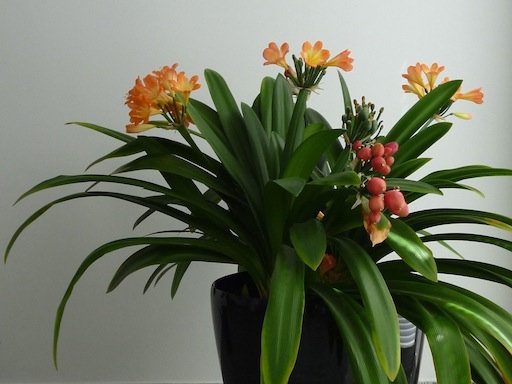
|
Liena had, already in Marum, a clivia, that always moved along. Lay-offs have flowers every year. |
The few years at the Guldenstraat must have been happy ones. The children were "grown up", Klaas the youngest was 10, the two eldest, Freerk and Renske, had married and came with grandchildren. And the garden must have been marvellous, with the afternoon Sun. Many pictures have been taken there. There are two photos where the young ones laugh hilariously because the garden bench broke down (see clips, bank).
In 1929 the house was put on sale my mister Lutteke and sold in October. Klaas and Liena now had to leave. They moved with Wieb, Sien, Lien, Dien en Klaas to an upstairs flat at the beginning of the W.A.Scholtenstraat. The flat had a large balcony facing south.

|
At the Guldenstraat, Klaas was already ill, he had stomach cancer.
At the W.A.Scholtenstraat, daughter Jo took care of him.
He died in 1932.
A year later, Liena died of bladder cancer.
Klaas and Liena were both interred in Marum.
Hens married in 1928,
divorced soon and was dressmaker and had her own workshop
at the Nieuwe Kerkhof in Groningen,
Jo found after 1933 work in Assen.
Daughter Lien had by that time married Jan Mantjes.
Wieb, Sien, Dien and Klaas stayed on at the W.A.Scholtenstraat.
In 1937 the last "children" moved to the upstairs flat
of the shop of Sien (x Gerrit Vos) at the Binnen Damsterdiep 16.
Dien became hairdresser and Klaas went (yet later) in trade.
Wieb did the household at the Damsterdiep.
To
clippings and photos.
Back to ancestry Klaas and Liena.
To the dutch version.
